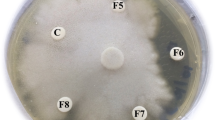Abstract
The action of allylamine antifungal agents on Epidermophyton floccosum was studied using scanning electron microscopy. After 7 days of culture on Sabouraud dextrose agar, Epidermophyton floccosum samples were brought in contact with concentrations of 0.2 and 2 μg ml−1 and 0.01 and 0.1 μg ml−1 of naftifine and terbinafine, respectively. Lesions observed after 24 h, 3 and 7 days of contact were mainly on the structure and rigidity of the mycelial and macroconidial wall. They were characterized by hyphal ballooning and twisting and by apical bulbous bulges. Deterioration of macroconidia was characterized by wall exfoliation. The intensity of the deterioration depended on the dose and only slightly on the length of time that the sample and the antifungal drug were in contact.
Résumé
L'action des allylamines sur Epidermophyton floccosum est étudiée en microscopie électronique à balayage. Après 7 jours de culture sur le milieu gélosé de Sabouraud, les échantillons d'Epidermophyton floccosum sont mis en contact avec des concentrations de 0,2 et 2 μg ml−1 et 0,01 et 0,1 μg ml−1 de naftifine et de terbinafine respectivement. Les lésions observées après 24 h, 3 et 7 jours de contact portent principalement sur des modifications de l'aspect morphologique des filaments mycéliens et des macroconidies. Elles sont caractérisées sur le mycélium par des ballonnements, des torsions et des apex bulbiformes. Sur les macroconidies on observe une exfoliation importante de leur paroi. L'intensité de ces lésions est dépendante de la dose et seulement faiblement dépendante du temps de contact entre l'échantillon et l'antifongique.
Similar content being viewed by others
References
Butty P. Activité antifongique et mode d'action des allylamines sur les dermatophytes: évaluation de la concentration minimale inhibitrice et étude en microscopie électronique. Thèse de Doctorat en Biologie Santé, Montpellier, France, Faculté de Pharmacie, 1991; 215 pp.
Gueho E, Castro I, Badillet G. Existence of ornementation on macroconidia and hyphae of Epidermophyton floccosum. J Inst Pasteur (Microbiol) 1985; 136: 195–207.
Meingassner JG, Sleytr N, Pétrany G. Morphological changes induced by naftifine, a new antifungal agent in Trichophyton mentagrophytes. J Investig Dermatol 1981; 77: 444–51.
Dall'Olio G, Vannini GL, Mares D. The effects of Coumarin on Trichophyton mentagrophytes light and electron microscopic studies. Ann Univ Ferrara Sez IV Bot 1974; 4: 151–8.
Borgers M. Structural degeneration of Aspergillus fumigatus after exposure to saperconazole. J Med and Veter Mycol 1989; 27: 381–9.
Kitajima Y, Nozawa Y. Isolation, ultrastructure and chemical composition of the autermost layer (‘exolayer’) of the Epidermophyton floccosum cell-wall. Biochim Biophys Acta 1975; 394: 558–68.
Hellgren L, Liljemark A. Vincent J. Studies on the biological effects of deuteriated organic compounds. II. Morphological changes of Epidermophyton floccosum exposed to perdeuteriated n-Hendecanoic acid studied with interference contrast and scanning electron microscopy. Mycopathologia 1976; 58: 149–52.
Osumi M, Yamada N, Yamada Y. Yamaguchi H. The effect of bifonazole on the structure of Trichophyton mentagrophytes. Dermatologia 1984; 169: 19–32.
Sayag J. Trichophyton: a century of progress. Ann Dermatol Venereol 1989; 116: 947–54.
Ryley JF. Chemotherapy of fungal diseases. Springer-Verlag, Berlin, Heidelberg, 1990.
Gooday GW, Graham W. Chitin metabolism. A target for antifungal and antiparasitic drugs. In: Borowski E, Shugar D, eds. Molecular aspects chemotherapy. Proceedings International Symposium, 2nd. New York: Pergamon 1990: 175–85.
Ivessa E, Daum G, Paltauf F. Mécanisme d'action de la naftifine. Mykosen 1987; 1/87: 20–9.
Ryder NS. Selective inhibition of squalene epoxidation by allylamine antimycotic agents. In: FEMS Symp. Microbial, cell wall synthesis and autolysis. Elsevier Publishers, Amsterdam 1984; 27: 313–21.
Blank H, Taplin D, Roth FJ. Electron microscopic observations of the effects of griseofulvine on dermatophytes. Arch Dermatol Syphil 1960; 81: 667–80.
Poulain D, Biguet J, Deblock S, Vernes A. La paroi mycélienne de Trichophyton mentagrophytes: Etude ultrastructurale de ses couches constitutives après application d'une méthode de mise en évidence des polysaccharides. Sabouraudia 1975; 13: 244–54.
Author information
Authors and Affiliations
Rights and permissions
About this article
Cite this article
Butty, P., Mallié, M. & Bastide, J.M. Antifungal activity of allylamines on Epidermophyton floccosum: scanning electron microscopy study. Mycopathologia 120, 147–153 (1992). https://doi.org/10.1007/BF00436392
Received:
Accepted:
Issue Date:
DOI: https://doi.org/10.1007/BF00436392




